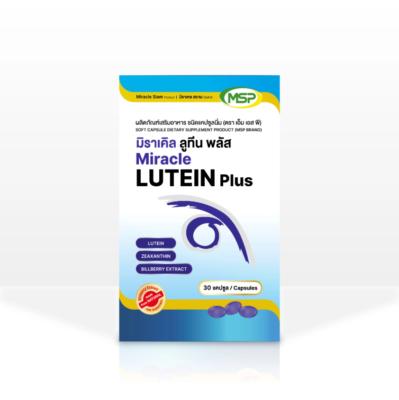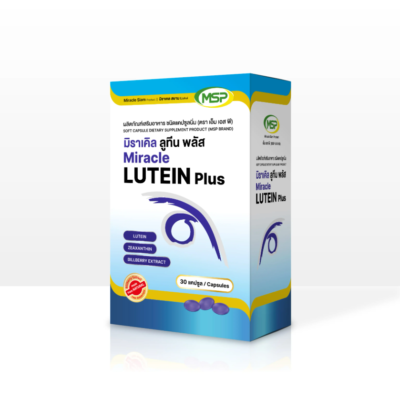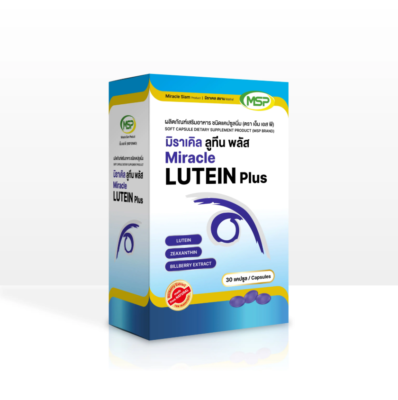Lutein: Can Lutein Benefit Your Eye Health?
Lutein and its isomer zeaxanthin commonly found in nature, is a lipophilic pigment belonging to the xanthophyll family of dietary carotenoids [1]. Carotenoids can be divided into carotenes, e.g., α-carotene, β-carotene, lycopene, torulene, isorenieratene, and their oxygen derivatives, xanthophylls, containing oxygen in the molecule in the form of hydroxyl, epoxy, or carbonyl groups, e.g., lutein, zeaxanthin, canthaxanthin, astaxanthin, and echinaxanthin.
Xanthophylls are more polar molecules than carotenoids because they have hydroxyl groups in the carbon ring of the molecule, which allows them to absorb light with shorter wavelengths. Xanthophylls are abundant in nature, with a group of compounds showing both chemical and physicochemical similarity [2].
The most prevalent isomer in the tissues that are involved in vision (the eye and brain) is lutein. Except for the vitreous, cornea, and sclera, almost all of the human ocular structures contain lutein, zeaxanthin, and metabolites. The highest concentration of lutein and zeaxanthin in the eye is in the macula of the retina [3].
One of the most prevalent carotenoids in the human diet, lutein is frequently consumed along with zeaxanthin. Approximately 20% of all carotenoids are composed of lutein and zeaxanthin together. The richest food sources of lutein are all dark green leafy vegetables, especially kale, spinach, lettuce, and broccoli.
Vegetables are a better source of these xanthophylls than fruits. The highest amount among fruits is found in nectarines, blackberries, avocados, raspberries, gooseberries, kiwi fruits, and black currants [1, 2].

Relation to Diseases
Age-related Macular Degeneration (AMD)
Strong evidence suggests that lutein and zeaxanthin protect against the development of Age-related Macular Degeneration (AMD), the cause of blindness in persons over 40 years of age in the United States. AMD is a condition that causes progressive vision loss and develops as a result of a complex interplay of environmental, multiple dietary and genetic factors that affect oxidative stress, inflammation, and light damage [3].
There is an abundance of oxygen in the retina of the human eye. Long-chain polyunsaturated fatty acids in the retina are reduced by prolonged or repetitive exposure to light, which also causes an increase in lipid-conjugated dienes, selective photoreceptor degradation, and retinal damage.
Reactive oxygen species (ROS), produced by oxidative stress and including free radicals, hydrogen peroxide, and singlet oxygen, cause cellular damage, promote the aging process in the retina, and eventually lead to the progression of AMD.
For quenching these ROS and protecting retina from AMD, a particular transmembrane orientation of macular xanthophylls has been proposed. Macular xanthophylls located transversely in the lipid bi-layer of the retinal membrane are able to prevent AMD and protect the retina against peroxidation and photo-damage by acting as antioxidants that quench free radicals and ROS.
Additionally, they significantly prevent blue light exposure to the photoreceptors in the fovea [4]. In addition to retinal effects, supplementation with lutein has been demonstrated to lower circulating levels of a rate-limiting enzyme of the alternative complement activation pathway that may play an important role in inflammatory response and the development of AMD [3].

Diabetic Retinopathy (DR)
A third of people with diabetes are affected by Diabetic Retinopathy (DR), one of the most prevalent microvascular consequences of diabetes [5]. Diabetes causes alterations in the retina’s metabolism, structure, and function because of the high glucose levels that weaken the electron transport chain system, produce superoxide, damage mitochondrial DNA, and reduce the amount of proteins that are encoded by the mitochondrial DNA [4].
Carotenoids, tocopherol, and ascorbate are antioxidants that protect against ocular oxidative damage. Carotenoids have the ability to neutralize free radicals, scavenge reactive oxygen species, regulate gene expression, reduce inflammation, and prevent diabetes-related microvascular complications, including diabetic retinopathy, nephropathy, and neuropathy.
Due to its potent anti-inflammatory and antioxidant properties, macular pigment (MP), which includes lutein, zeaxanthin, and mesozeaxanthin, also contributes to the protection of the retinal tissue in diabetics. It has been established that patients with type 2 diabetes have a lower level of MP as compared to healthy controls.
Supplemental lutein has been shown to protect the retina against oxidative damage [4]. The protective effects of carotenoids on visual function in the diabetic state were demonstrated in a retrospective study of type 2 diabetic patients, which found that supplementing with lutein and zeaxanthin can improve retinal thickness and function as measured by optical coherence tomography (OCT) and multifocal electroretinography (mfERG) [5].

Cataract
Cataract is one of the most common age-related eye diseases. It is thought to affect 95 million people worldwide and is a major factor in about 90% of blindness in developed countries. It is characterized by the clouding or opacification of the lens, which reduces the amount of light passing through to reach the retina and causes vision to become blurry. Although there are several contributing factors to cataracts, aging is thought to be the most common risk factor [5].
The lens, which is located in the front of the eye, is constantly exposed to oxidative stress from sources including UV light. A number of antioxidant defense systems including antioxidant enzymes such as superoxide dismutase and antioxidants are utilized in the lens to protect against oxidative stress-mediated damages [5].
For many years, antioxidant properties of carotenoids have been understood. In a pioneering study, Kellogg III and Fridovich discovered that β-carotene significantly inhibits lipid peroxidation caused by xanthine oxidase. Chemical antioxidants like α-tocopherol, β-carotene, ascorbate, and glutathione (GSH) are implicated in preventing oxidative damage of the ocular tissues.
According to some theories, the antioxidants lutein and zeaxanthin are continually transported from the body pool to the epithelial/cortical layer of the lens, where they scavenge ROS by enhancing the activities of GSH, catalase, and superoxide dismutase (SOD). Gao et al. (2011) reported that lutein and zeaxanthin could reduce the risk for senile cataract by protecting lens protein, lipid, and DNA from oxidative damage [4].
Dry Eye Syndrome (DES)
Dry Eye Syndrome (DES) is a multifactorial disease of the tear film and ocular surface of the eye that causes decreased tear production, discomfort-related symptoms, and visual disturbances, as well as the possibility of ocular surface injury.
The prevalence of various DES symptoms has increased further as a result of increased usage of light-emitting diode displays, including those found in computers, flashlights, and cell phones. The pathophysiology of DES includes loss of tear film, tear hyperosmolarity, oxidative stress, and inflammation of ocular surface that result in a vicious cycle of ocular surface damage and inflammation.
Patients with dry eyes have higher levels of inflammation in their tears, which is mediated by pro-inflammatory cytokines like tumor necrosis factor-alpha (TNF-α), interleukin (IL)-6, and IL-8. The secretion of lacrimal glands is weakened as a result of these cytokines’ inhibition of neurotransmitter release and the activity of sensory nerves on the ocular surface.
The macula of the eye contains high concentrations of the xanthophyll carotenoids lutein and zeaxanthin, which absorb high-energy blue light and shield the retina from phototoxicity.
These substances also function as antioxidants and scavenge free radicals. Moreover, it is known that lutein and zeaxanthin inhibit inflammatory pathways including lipopolysaccharide-induced secretion of IL-8 and hyper-osmotically induced secretion of IL-6 in corneal epithelial cells [6].
Extra-Eye Action: Cognitive Function
Macular Pigment Optical Density (MPOD), considered a stable measure of lutein and zeaxanthin in neural tissues, has been associated with better global cognition, verbal learning and fluency, and processing and perceptual speed in healthy young and old people.
Plasma or retinal levels of lutein and zeaxanthin have been linked to improved brain activity, white matter integrity, and neural efficiency. Interventional studies also provide support that taking supplements of lutein and/or zeaxanthin may improve cognitive function and help maintain cognitive health.
The effect of lutein and zeaxanthin consumption (supplementation or dietary intervention) on cognitive functioning in healthy young and more mature adults has been studied in 13 randomized, double-blind, controlled interventional trials to date [1].
It has been found through the use of functional magnetic resonance imaging that lutein may improve cerebral perfusion or neural efficiency in older adults, and two studies have shown a relationship between MPOD and some aspects of cognitive function, such as prospective memory or verbal fluency and processing speed [7].
Safety
Lutein is a very safe molecule that has been consumed in the diet at various doses for a very long time. In several toxicity studies, including developmental toxicity and dermal irritation, no adverse effects were documented in animals, including monkeys or humans [1]. While there is a lack of conclusive information on the optimal lutein supplementation dosage, numerous studies have found that lutein has a reasonably high safety profile, and the US Food and Drug Administration (FDA) has classified it as Generally Regarded as Safe (GRAS) [5].
Excessive lutein consumption appears to have mild and rarely reported side effects. There is one case study reporting bilateral “foveal sparkle” in an elderly Asian woman who consumed a daily 20 mg lutein dose, which resulted in an extraordinarily high lutein level, and a high intake of dietary lutein (broccoli, kale, spinach, and avocado smoothie every morning) for a duration of 8 years. Seven months after stopping the lutein, crystals in the inner layers of the foveal region of her right eye gradually dissolved, but the crystal in her left eye persisted [5].
References
- Gazzolo D, Picone S, Gaiero A, Bellettato M, Montrone G, Riccobene F, et al. Early Pediatric Benefit of Lutein for Maturing Eyes and Brain-An Overview. Nutrients. 2021 [cited 2023 July 17]; 13: 1-26. Available form: https://www.ncbi.nlm.nih.gov/pmc/articles/PMC8468336/
- Mrowicka M, Mrowicki J, Kucharska E, Majsterek I. Lutein and Zeaxanthin and Their Roles in Age-Related Macular Degeneration-Neurodegenerative Disease. Nutrients. 2022 [cited 2023 July 17]; 14: 1-14. Available form: https://www.ncbi.nlm.nih.gov/pmc/articles/PMC8874683/
- Mares J. Lutein and Zeaxanthin Isomers in Eye Health and Disease. Annu Rev Nutr. 2016 [cited 2023 July 17]; 36: 571-602. Available form: https://www.ncbi.nlm.nih.gov/pmc/articles/PMC5611842/
- Johra F, Bepari A, Bristy A, Reza H. A Mechanistic Review of β-Carotene, Lutein, and Zeaxanthin in Eye Health and Disease. Antioxidants (Basel). 2020 [cited 2023 July 19]; 9: 1-21. Available form: https://www.ncbi.nlm.nih.gov/pmc/articles/PMC7692753/
- Li LH, Lee JC, Leung HH, Lam WC, Fu Z, Lo ACY. Lutein Supplementation for Eye Diseases. Nutrients. 2020 [cited 2023 July 19]; 12: 1-27. Available form: https://www.ncbi.nlm.nih.gov/pmc/articles/PMC7352796/
- Muz O, Orhan C, Erten F, Tuzcu M, Ozercan I, Singh P, et al. A Novel Integrated Active Herbal Formulation Ameliorates Dry Eye Syndrome by Inhibiting Inflammation and Oxidative Stress and Enhancing Glycosylated Phosphoproteins in Rats. Pharmaceuticals (Basel). 2020 [cited 2023 July 19]; 13: 1-18. Available form: https://www.ncbi.nlm.nih.gov/pmc/articles/PMC7599565/
- Buscemi S, Corleo D, Di Pace F, Petroni ML, Satriano A, Marchesini G. The Effect of Lutein on Eye and Extra-Eye Health. Nutrients. 2018 [cited 2023 July 19]; 10: 1-24. Available form: https://www.ncbi.nlm.nih.gov/pmc/articles/PMC6164534/
- MIRACLE LUTEIN PLUS | MIRACLE SIAM PRODUCT https://msp-th.com/en/products/miracle-lutein-plus
- Nutrients for eye health | MIRACLE SIAM PRODUCT https://msp-th.com/en/articles/nutrients-for-eye-health

